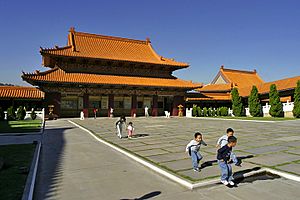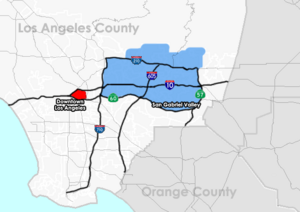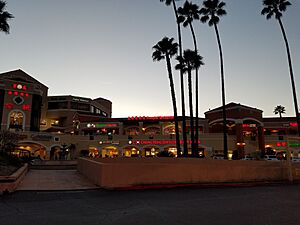Chinese enclaves in the San Gabriel Valley facts for kids
Quick facts for kids San Gabriel Valley |
|||||||||||||||
|---|---|---|---|---|---|---|---|---|---|---|---|---|---|---|---|

Hsi Lai Temple in Hacienda Heights, the second largest Buddhist temple and monastery in the Western hemisphere.
|
|||||||||||||||
| Simplified Chinese | 圣盖博谷 | ||||||||||||||
| Traditional Chinese | 聖蓋博谷 | ||||||||||||||
|
|||||||||||||||
| Alternative Chinese name | |||||||||||||||
| Simplified Chinese | 圣加布里埃尔谷 | ||||||||||||||
| Traditional Chinese | 聖加布里埃爾谷 | ||||||||||||||
|
|||||||||||||||
| Second alternative Chinese name | |||||||||||||||
| Simplified Chinese | 圣加百利谷 | ||||||||||||||
| Traditional Chinese | 聖加百利谷 | ||||||||||||||
|
|||||||||||||||
The San Gabriel Valley is a region just east of Los Angeles, California. It is well-known for its large Chinese communities. Many Chinese immigrants, also called hua qiao, have made this area their home.
Chinese people have been part of Southern California since the 1800s. But a big move of Chinese immigrants to the San Gabriel Valley happened from the 1970s onwards. At that time, many people were moving out of the area. This created a chance for educated and wealthy Asian Americans to settle there. They first moved mainly to Monterey Park.
As Monterey Park became crowded and expensive, the Chinese community spread out. They moved to other nearby cities in the western San Gabriel Valley. These cities include Alhambra, Arcadia, Rosemead, San Marino, San Gabriel, South Pasadena, and Temple City. The community also moved eastward to places like Diamond Bar, Hacienda Heights, Rowland Heights, and Walnut. Many businesses that speak Mandarin and Cantonese have opened in these areas. They serve the growing Chinese population.
Contents
History of Chinese Communities
The San Gabriel Valley has a long history with Asian settlers. In the mid-1800s, Chinese, Japanese, Filipino, and South Asian pioneers came here. They worked on farms growing grapes and citrus fruits. They also helped build early roads and buildings.
However, laws like the Chinese Exclusion Act of 1882 made it hard for Asian people. Later, in 1942, many Japanese Americans were sent to special camps. These laws stopped Asian communities from growing for many years. The main Asian cultural centers were Chinatown and Little Tokyo in Downtown Los Angeles.
Things began to change after 1965. A new law, the Immigration and Nationality Act of 1965, allowed many more Asian immigrants into the United States. About 20 million Asian immigrants came, and many settled in Monterey Park. They liked it because it was close to Chinatown and had good schools.
By 1996, about 65% of Monterey Park's population was Asian, mostly Chinese. As more Asian Americans moved to the San Gabriel Valley, new business areas opened. These areas were made to serve the needs of the growing community. Many Chinese immigrants preferred these new suburban areas over the older "touristy" Chinatown in Downtown Los Angeles.
In 1988, Monterey Park tried to slow down its rapid growth. They passed a rule to stop new building for a while. This rule was challenged and did not last long. But it caused many Asian residents and businesses to move to nearby Alhambra. From there, they spread to even more neighborhoods.
These new Chinese communities in San Gabriel Valley look different from old Chinatowns. They have many Chinese-language signs. But they do not have the traditional Chinese gateways called paifang.
This area has become a major cultural center for many Asian Americans. It is a place with different generations and many Asian ethnic groups. In the 2000s, these communities, sometimes called "ethnoburbs," have continued to grow and become even more diverse.
Local Communities

The San Gabriel Valley has several suburban areas with a strong Chinese focus. These places are often called by their city name, not "Chinatown." But Monterey Park was sometimes called the "First Suburban Chinatown."
These Asian communities stretch for about 25 miles along Valley Boulevard. This road goes from Alhambra in the west to Diamond Bar in the east. The communities also extend north to San Marino and Arcadia. To the south, they reach Hacienda Heights and Rowland Heights.
San Gabriel has become a popular spot for Chinese tourists. Its business district around the San Gabriel Mall is very busy. More hotels are being built because many Chinese tourists like to stay in San Gabriel. They do this even if they plan to visit other famous places in Southern California.
Younger Chinese Americans in the area often connect with "626." This is the area code for much of the San Gabriel Valley. They speak English well but still feel connected to their parents' culture. They have created new things, like songs that mix Chinese dialects with American hip-hop. Boba, a sweet tea with chewy tapioca pearls, is a popular drink and a cultural symbol of "626." The famous food festival 626 Night Market in Arcadia, California is also named after this area code.
Monterey Park
Starting in the 1970s, immigrants from Taiwan began moving to Monterey Park. They also settled in nearby Alhambra and Rosemead. This area was close to the old Los Angeles Chinatown. It was becoming a Chinese-influenced community. Many wealthy Chinese professionals, mostly from Taiwan, moved here. Real estate agents in Taiwan and Hong Kong even called Monterey Park the "Chinese Beverly Hills." They wanted to attract more investors.
The old Downtown L.A. Chinatown was too crowded for the many Chinese people leaving Taiwan and Hong Kong. Later, other Mandarin-speaking immigrants from Taiwan and Mainland China also came. The city grew even faster in the 1980s. This was because many people were moving out of the San Gabriel Valley. New Chinese shopping centers, with large Asian supermarkets, were built for the new residents.
Monterey Park became known as the "first suburban Chinatown" in North America. It was featured in famous magazines like Forbes and Time. It was also in the Los Angeles Times.
For a time in the late 1970s, Monterey Park was informally called "Little Taipei." This was because of the many immigrants from Taipei, the capital of Taiwan. The city council tried to make a rule that all business signs had to have English. They said it was for safety reasons for police and fire departments.
Monterey Park has more than 60 Chinese restaurants and many other Chinese businesses. These include realty companies, supermarkets, and offices for doctors, dentists, and lawyers.
The Chinese American population in Monterey Park is very diverse. It includes people from different backgrounds, like Chinese from Vietnam and Indonesia. In Monterey Park, about 61% of the people are Asian American. In Alhambra, Arcadia, and San Gabriel, about 49% are Asian.
San Gabriel
The city of San Gabriel mixes Asian, European, and North American cultures. Many Chinese Americans, including second and third generations, visit its many stores and restaurants.
There is a large shopping center called "San Gabriel Square." The Los Angeles Times called it "the great mall of China." This area has many Chinese shops and buildings with Spanish-style tile roofs. It has become a model for new "ethnoburbs" in other places like Las Vegas Valley and Houston.
This area has many restaurants, cafes, shops, and markets. You can find hair and nail salons, Asian video stores, and health services. There are also department stores and a big jewelry mart. It offers something for everyone, from buying expensive diamonds to shopping for soy milk. You can even find travel packages to Las Vegas or China.
Alhambra

In 1992, Alhambra and Monterey Park held their first Chinese New Year parade and street festival together. Later, Alhambra held the parade with its neighbor San Gabriel. This parade and festival have many sponsors. It is shown on Chinese-language radio and TV in Los Angeles.
Rowland Heights
Rowland Heights is a major Chinese business and cultural center in the East San Gabriel Valley. It has many Taiwanese and Mainland Chinese businesses. These include restaurants, banks, and offices. They are found in many shopping centers. The population here is now about 55% Asian.
Hacienda Heights
Nearby in Hacienda Heights, the Hsi Lai Temple was built in 1988. It is a Buddhist temple. Some local people did not want it built at first. But now, it is a respected part of the community. Important people, like members of the U.S. House of Representatives, often visit during big events. The Hsi Lai Temple is the largest Buddhist temple in the Western Hemisphere.
Other areas in the Eastern San Gabriel Valley with many Asian residents include West Covina, Walnut, and Diamond Bar.
Temple City
In Temple City, about 39% of the population was Asian in 2000. This number is likely much higher now. Along Las Tunas Boulevard, there is a "Bridal District" of Asian businesses. This area has become a popular place for all wedding needs. Asian brides often wear three gowns. There are also many florists and fancy portrait studios. These support the Asian tradition of taking professional photos of the bride and groom before the wedding. Asian brides come from far away, even New York City, to visit this special area in Temple City.
Valley Boulevard Corridor
Valley Boulevard is a very important and growing area for businesses. It has many Asian markets, restaurants, and other services. You can find doctors and dentists here. There are also many Asian banks and businesses owned by Asian people. These serve the large Asian population.
The Asian communities in the San Gabriel Valley stretch along 25 miles of Valley Boulevard. It starts in Alhambra on the west side and goes to Diamond Bar on the east side.
Valley Boulevard begins near downtown Los Angeles. It runs east through industrial areas and the community of Lincoln Heights. In Lincoln Heights, there is the Ming Ya Buddhist Temple.
After Los Angeles, Valley Boulevard enters Alhambra. Alhambra is about 47% Asian. It has many Asian businesses along the Boulevard. This area is known for its noodle shops and Asian cafes. The Wing Lung Bank here has a huge glass tile mural. Each year, Alhambra and San Gabriel host one of the biggest Chinese New Year celebrations in the country. It includes a parade along Valley Boulevard.
Further east are the cities of San Gabriel and Rosemead. San Marino, Temple City, and Arcadia are a bit further north and east. These five cities have Asian populations between 40% and 55%. They also have many Asian businesses in their town centers. In Arcadia, new homes are being built to attract wealthy Chinese buyers.
Along Valley Boulevard in San Gabriel, there are many Asian mini-malls and hundreds of shops and restaurants. San Gabriel Square is a very famous one. It has a 99 Ranch Market and many shops and restaurants. You can find Taiwanese and vegetarian food there. This area is also known for its tofu and dumpling houses.
Continuing east from Rosemead, Valley Boulevard goes through El Monte and La Puente. These areas have many industrial businesses. Many of these are Asian-owned wholesale businesses. They import electronics, food, and furniture from Asia.
On the east side of the San Gabriel Valley, before Valley Boulevard becomes Holt Avenue in Pomona, are Hacienda Heights, Rowland Heights, Walnut, and Diamond Bar. These three communities have Asian populations between 40% and 60%. Rowland Heights and parts of Hacienda Heights have their own small ethnic suburbs. These include businesses along Azusa Avenue, Colima Road, and Nogales Street. Indoor malls in Rowland Heights have restaurants and stylish Asian shops.
Population Data
Here is a list of cities and areas in the San Gabriel Valley. It shows the number and percentage of Chinese Americans (including Taiwanese Americans) living there. This data comes from recent surveys.
| City/CDP | Chinese Including Taiwanese (2011-2015 ACS) |
Percentage (2011-2015 ACS) |
Chinese (2010 Census) |
Taiwanese (2010 Census) |
|---|---|---|---|---|
| Alhambra | 30,683 | 36.2 | 31,493 | 1,866 |
| Altadena | 624 | 1.4 | 728 | 40 |
| Arcadia | 26,229 | 45.6 | 21,744 | 4,846 |
| Avocado Heights | 861 | 5.4 | 433 | 22 |
| Azusa | 1,062 | 2.2 | 801 | 115 |
| Baldwin Park | 5,951 | 7.8 | 4,086 | 259 |
| Bradbury | 139 | 16.6 | 98 | 47 |
| Charter Oak | 154 | 1.7 | 224 | 11 |
| Citrus | 140 | 1.2 | 111 | 23 |
| Claremont | 2,649 | 7.4 | 1,732 | 317 |
| Covina | 2,012 | 4.1 | 1,453 | 273 |
| Diamond Bar | 15,203 | 26.9 | 12,547 | 3,162 |
| Duarte | 1,211 | 5.6 | 889 | 82 |
| East Pasadena | 1,019 | 16.8 | 842 | 196 |
| East San Gabriel | 6,109 | 38.2 | 4,965 | 809 |
| El Monte | 19,837 | 17.1 | 16,151 | 816 |
| Glendora | 1,314 | 2.6 | 1,207 | 137 |
| Hacienda Heights | 15,127 | 27.4 | 11,348 | 2,944 |
| Industry | 13 | 3.0 | 17 | 2 |
| La Cañada Flintridge | 1,252 | 6.1 | 1,260 | 78 |
| La Habra Heights | 563 | 10.4 | 361 | 60 |
| La Puente | 1,839 | 4.5 | 1,010 | 86 |
| La Verne | 849 | 2.7 | 707 | 72 |
| Mayflower Village | 1,162 | 21.4 | 903 | 146 |
| Monrovia | 2,623 | 7.1 | 1,605 | 199 |
| Montebello | 3,377 | 5.3 | 2,749 | 82 |
| Monterey Park | 27,244 | 44.6 | 29,537 | 1,233 |
| North El Monte | 1,072 | 26.0 | 869 | 114 |
| Pasadena | 8,848 | 6.3 | 7,316 | 887 |
| Pomona | 4,899 | 3.2 | 3,460 | 445 |
| Rosemead | 19,480 | 35.7 | 20,548 | 461 |
| Rowland Heights | 18,276 | 36.2 | 16,563 | 3,476 |
| San Dimas | 2,015 | 5.9 | 1,000 | 169 |
| San Gabriel | 16,893 | 42.0 | 17,137 | 1,009 |
| San Marino | 5,776 | 43.3 | 4,707 | 1,498 |
| San Pasqual | 185 | 9.3 | 206 | 39 |
| Sierra Madre | 744 | 6.7 | 427 | 27 |
| South El Monte | 1,004 | 5.1 | 1,222 | 33 |
| South Pasadena | 3,432 | 13.2 | 4,132 | 428 |
| South San Gabriel | 1,941 | 21.8 | 2,385 | 38 |
| South San Jose Hills | 563 | 2.7 | 566 | 64 |
| Temple City | 15,741 | 43.6 | 13,931 | 1,964 |
| Valinda | 522 | 2.2 | 645 | 36 |
| Vincent | 576 | 3.4 | 322 | 16 |
| Walnut | 10,296 | 34.4 | 9,242 | 2,064 |
| West Covina | 10,534 | 9.8 | 9,089 | 1,347 |
| West Puente Valley | 698 | 2.9 | 468 | 20 |
| Whittier | 965 | 1.1 | 923 | 103 |




